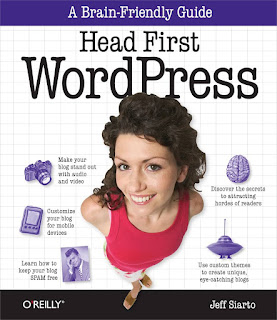Head First Wordpress
Download
Introduction
1.Getting started: WordPress from scratch
You’ve got something to say. Whether it’s just you and your desire to let everyone know about your growing
collection of hand-crocheted Star Wars figures, or a big company with
hundreds of products, blogging let’s anyone publish online without having
to be a genius about HTML, CSS, or any other programming. In this chapter,
you’ll learn how to get hosting for your blog, install WordPress, and create
and publish your first blog post.
2. Changing your blog’s look and feel: A question of style
You’ve finally got your own blog. But it looks so...generic.
Time to make it your own. WordPress comes preloaded with lots of themes you can
apply to your blog, but we’re going to go one step further and make our own custom
theme. Along the way, you’ll learn some basic HTML and CSS to really make your blog
look exactly how you want. We’ll also delve into CSS rules, which allow you to quickly
change how your blog looks, and take advantage of WordPress widgets to easily add
sidebar content to the blog
3. Content management with wordpress: Beyond the blog
You’re starting to outgrow the blog.
Maybe your business is growing, maybe you need more control of what shows up
where on your blog, and when. Luckily, WordPress handles a lot more than just
chronological blog posts. We’ll start to tap into its content management system
capabilities by creating static pages like on a regular website, adding navigation for the
new pages, and changing the home page of your new site so it isn’t your blog. Get ready
to build a full-fledged website practically without writing a single line of HTML or CSS.
4. Users, categories, and tags: Keeping things organized
It’s time to invite some friends to the party.
Blogging (or managing a WordPress site) doesn’t have to be a solitary venture.
Loads of well-know blogs out there feature multiple user roles, from writers to
editors and administrators. In this chapter, you’ll learn how to get multiple people
posting on the same blog, manage the workflow across all those people, and put
categories and tags to work in organizing your site’s content.
5. Video and plug-ins: Getting things moving
Video can add a whole other dimension to your blog. For nearly
any kind of content, video makes your site more engaging, and gives you readers
plenty more to comment on and share with their friends. In this chapter, you’ll learn
how to host your videos online and include them (along with other downloadable
files) in your blog posts. We’ll introduce plug-ins, which do a lot of heavy lifting (and
coding) for you, and use categories to create a consistent, easy-to-find home for all
the videos on your site.
6. Podcasting and syndication: Spreading the word
It’s time more people knew about your awesome site.
Your blog is humming along, and you’ve already figured out how to expand WordPress to
manage an entire website. Now that you’ve got video playing there too, why not expand
your audience base? In this chapter, we’ll discover how to distribute videos through
Apple’s iTunes store as podcasts, and how to syndicate your content so that a ton more
people will find out about your site (and keep coming back for more).
7. Securing wordpress: Locking things down
Not everyone on the Internet is nice.
It’s a fact of modern life on the Internet: there are people who spend their time trying
to break into, or hack, other people’s websites. Some do it just for the thrill, others
to cause chaos, and some are simply after sensitive information like credit card
numbers, social security numbers, and other personal information. Now, you’ll learn
how to make your WordPress site more secure, with unique usernames, strong
passwords, and more. You’ll also kick off automatic backups of all your WordPress
files so you can restore your site if it ever does get hacked, or goes down for other
reasons.
8. Making wordpress fast: Time for the passing lane
Speed is important online.
A fast-loading site isn’t just about keeping visitors around. Yes, if your site doesn’t load
quickly then people might just wander off, but a slow site also gets dinged in search results
from the likes of Google, meaning fewer people will actually find your site in the first place.
Beyond just increasing your horsepower, you’ll also learn how to use caching, database
optimization, and additional hosting options to beef up your site to handle more traffic, too.
Home Web Development Head First Wordpress

